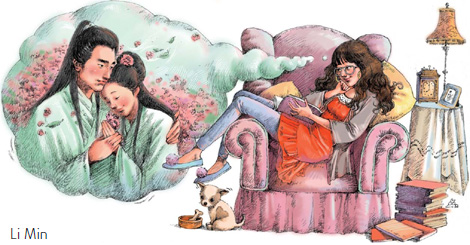Reading their hearts

As Valentine's Day falls on Chinese New Year's Day this year, both love and debate are in the air. And the changing times and views of amorousness can be read in the revival of romance novels.
Attitudes toward love have changed over the past three decades, and so has the passion for romance novels.
Readers in the Chinese mainland are no longer eyeing Western stories by Jane Austin and the Bronte sisters, or sentimental tales by Taiwan's Chiung Yao (Qiong Yao) and Xi Juan. Instead, they've shifted their attention to local writers.
According to Enjoy Reading Era, a Beijing-based cultural company specializing in publishing romantic novels, 1,500 love stories by writers in the mainland were published last year, an all-time high. The company exported 50 romance novels to Hong Kong and Taiwan, while it only imported three novels from Taiwan.
"The situation was in reverse a decade ago," says Hou Kai, manager of Enjoy Reading Era. "Time changes. Readers now identify more with romantic novels by mainland novelists, who provide fresh scenes and plots."
Back in the 1980s and 1990s, romantic novels from Hong Kong and Taiwan dominated the country's romantic novel market. Most of them had a contemporary setting, featuring protagonists for whom love was the priority.
A number of these romance novels were turned into TV series and movies. They, in turn, helped novels gain in popularity among teenagers and adults.
"It happened when China opened up. People began to focus on their feelings and emotions," says Hou, adding the personalized writing style of romantic novels brought warmth to readers, most of whom only had access to serious, revolutionary fictions.
As a genre of popular fiction, romantic novels were overlooked by mainstream writers and publishing houses decades ago.
"Love stories were considered of low artistic and cultural value," says literary critic Xia Lie. "Romantic novels were seen as works by unsuccessful writers."
But Xia adds the popularity of romantic novels is an indicator of social changes. He says, unlike other forms of literature, romantic novels target female readers, and development of the genre shows the rising social status of women.
The economies of Taiwan and Hong Kong began to take off in the late 1970s and women contributed a lot to it. They then had spare money for entertainment and some of them purchased romantic novels, Xia says.
"In the 1980s, we saw a rising demand for romance novels in the mainland."
However, readers found the themes and plots in romance novels from Hong Kong and Taiwan to be too limited over the years.
"There are not many surprises and I can predict the ending easily," says Ming Xiaoxi, a young university lecturer.
Dissatisfied, she wrote campus love stories for fun and posted them online. Much to her surprise, the stories received high acclaim from netizens and they re-posted the stories to more forums.
Ming is now a well-known writer with more than 10 published novels. Two of her stories, Angel Will Help Me Love You and Bubble Summer, have been adapted into TV series with A-list stars. She also writes stories with diversified themes, like time-travel, contemporary and historical love stories.
Ming is just one of thousands of amateur romantic novelists who have created love stories online. Many popular romantic novels have gained fame through literature websites first.
Hongxiu.com, a leading literature website targeting female readers, is famous for original romantic novels. Bi Jianwei, editor-in-chief of the website, claims it has attracted nearly 2 million online romantic works, receiving 30 million page visits every day by viewers aged from 18 to 35.
Stories written by well-known online writers are free for the first chapters, but the remaining chapters cost about 0.02 yuan (0.3 cent) for 1,000 Chinese characters, on average. Bi says pay-online reading has become a major source of income for the website, the other sources being copyright tradings with publishing houses. There are over 5,000 signed novelists on Hongxiu.com and some amateur novelists have turned full time. The growing number of writers and readers online makes Bi firmly believe in the saying: "Where there are women, there are romantic novels".
"It is a very competitive market," Bi says. "Online stories should have fascinating plots because readers are looking for entertainment and surprises. Writers have to be more creative and imaginative than their predecessors."
A popular theme of today's online romantic novels is time travel: A protagonist goes back in history or travels to the future to meet the other half. The female protagonists are, typically, determined and independent, which is a striking contrast to the stereotypical image of being timid, in previous romance fiction.
Besides the massive online reader base, many teenage fans purchase printed romances. Shen Hanying, editor of romantic novels from Memory House, a major publishing company for female literature, says their readers are between 14 and 18.
"Given the age, we are more careful in choosing to publish romantic novels. Romantic novels which contain sexual content is vetoed by most publishing houses," Shen says. "Online writers also know this rule. Some of them don't even write about a kiss, which they think is too bold and unnecessary for the story."
Having read over 100 romantic novels, Shen calls herself an "enthusiastic romantic novel fan". She says although romantic novels nowadays are still not taken seriously as literary fiction, they have a positive function.
"Most of them focus on the bright side of life and have optimistic endings. They also provide wisdom and guide readers to enjoy everyday life," Shen says.
"Who dares to say some of them will not be classics one day?" Shen adds. "Love is a universal topic and people are all equal in front of it. Romantic novels are a good record of people's attitude toward love in different times."
 0
0 







Go to Forum >>0 Comments